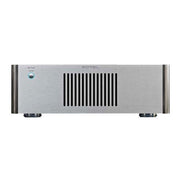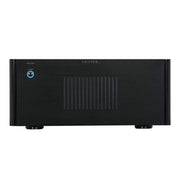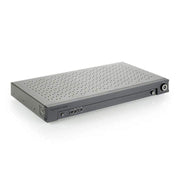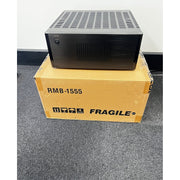The Amplifier Family - So Many Different Classes
Throughout the years dating back as far as the very early 1900’s right up to today, Amplifiers are continually being changed, enhanced and modified to fit the market and technology advancements at the present time. One main difference that exists in all amplifiers today is the output stages of the amplifiers, which is the based on the specific circuitry and how it manipulates and uses the input signal it receives. Most commonly consumer-based amplifiers are classed as A, AB and D with the exception of some additional less commonly used types B, C, E, F, G and H. The topography of these classes determines the way the current in its sinusoidal wave form is managed and distributed.
Class A Amplifiers
The fission reactor of amplifiers, 100% in with 100% out. Disputably the purest form of amplification that also will keep your house warm in winter. The topography of the design means that output power remains the same no matter if there is a signal or not. When there is no signal, the energy is converted into heat and the amplifier gets hot. Whereas when there is a signal present, the energy is sent to the speakers as current to make the intended sound and output. For comparatives sake, these amplifiers are 25% efficient in terms of how it uses the energy. The signal is completely managed from the single device and is not split as the case for other classes. This means the level of distortion is very low, but depending on the overall design of the device, the power supply has to be delicately selected to mitigate potential electrical noise.
Class B Amplifiers
The distortion master, class B amplifiers have an efficiency of close to 75% and work on “two way” style where the signal is split in half and at any one moment only half the signal is actively being processed. The output signal suffers due to the fact the signal splits from the positive 180 degrees of the signal wave to the negative 180 degrees of the signal wave. This leads to increased amounts of distortion termed crossover distortion due to the handover between the two halves of the signal. In terms of audio, home theatre and music reproduction, it is unlikely you will ever see a class B amplifier but in combination with class A you will find the most common and debatably most effective form of amplification.
Class AB Amplifiers
The hybrid master, by combining the best of class A and class B, it is intended to produce the best amplification without the individual drawbacks of the two individual classes. In terms of efficiency, class AB run around 50% efficient. The topography and design allow for the signal to be split much like the class B but instead of splitting the signal in half, there is a push-pull signal that covers over 180 degrees (up to 200 degrees and over half of the signal wavelength) of signal to prevent the crossover distortion. Being more efficient does not completely mitigate the heat production, which in turn adds the requirement for large heatsinks and sometimes active cooling which can lead to extra unwanted noise.
So, in terms of the above classes, the signal is pretty much managed the same, low input signal into amplifier and output high signal which ideally looks exactly the same as it came in.
Class D Amplifiers
The future of amplifiers? Class D is a technology that is very much growing and has a very large market and is growing in many ways in the audio industry. These amplifiers can be the size of your hand and still produce significant power in comparison to something 50 times larger. They are the most efficient amplifier, up to 100%, commonly used for audio and can match other classes. This means they are green on energy consumption and make a far smaller footprint on your area or audio environment. The key component that differs to other classes is the pulse-width-modulation of the signal. Simply put it is how the key componentry within the amplifier manages the signal pulses within the device compared to ramping voltage and outputs the results. This is a key difference as the signal in is not the same as the output signal. Filtration of the output is required to modulate the signal effectively to the speakers. This is the limiting factor with class D, the attention to detail and research required for class D circuitry is very important and needs to be top notch to compare to other classes.
Current class D amplifiers from reputable brands have dedicated technology and topography to mitigate noise, output a musical signal and compete with the power significantly of other amplifier classes. They are still dealing with an analog signal, it is a common misconception that it is a digital amplifier, and this signal with a lot of care can produce an excellent sound.
Class G Amplifiers
Class G amplifiers are designed to enhance the output stages of the class AB design by using more efficient techniques which then allow for greater efficiency and lower distortion. They use multiple power rails which operate at different voltages and then switch between them as the audio signal gets close to each level. This then allows the amplifier to be more efficient with less power wasted by the output transistors. While class G amplifiers are more efficient than class AB they are not as efficient as class D. Glass G is commonly used in Arcam amplifiers.
What to choose?
When it comes to selecting an integrated amplifier, no matter the class it will come down to your ideal system, your ears and budget. To a certain limit in my opinion, you get what you pay for, no matter the class, there will be poor and excellent performers and with a bit of research to find a trusted brand you will find a product with the structure and function to suit your dream system. Thankfully there is not a shortage of amplifiers out there, and excellent people to talk to when it comes to choosing one.
Get into a store, choose an amp, choose some speakers, choose a source, have your favourite music and sit and enjoy the journey testing as much as possible.
SHOP THE BEST AMPLIFIERS ONLINE NOW, AT CHT SOLUTIONS

Rotel RB-1552 MKII Stereo Power Amplifier

Rotel RMB-1555 Multi-channel Power Amplifier

Monitor Audio Subwoofer Amplifier - IWA-250

Rotel RMB-1555 Black - 5ch Power Amplifier - Open Box
Shop all the best Integrated Amplifiers and Power Amplifiers at CHT Solutions today and reach out to our friendly team of experts for any advice.







